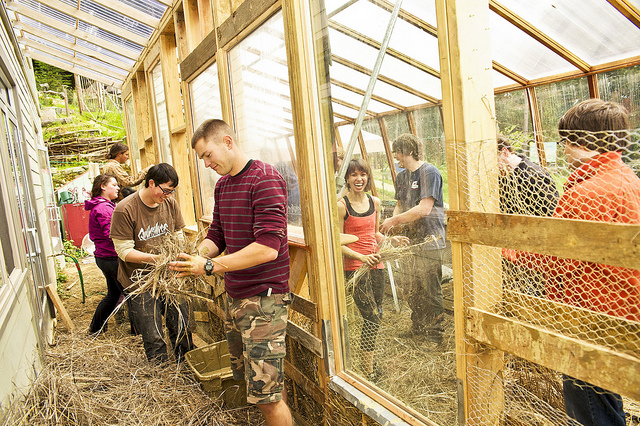
Located in the Buck House just south of the Behavioral and Social Sciences building, CCAT commemorates fall with a combined Harvest Festival and a special anniversary celebration starting at 2 p.m. The day features CCAT-alumni-led workshops, tours, story telling, a potluck dinner and music by the Compost Mountain Boys.
CCAT started in 1978 as a student project sponsored by HSU’s Youth Educational Services. Two years later students took up residence in the Buck House, which they still occupy today in the house’s modified form—a ground floor was added in 2007 while the original structure makes up the second story.
With assistance from Professor Peter Lehman, founding director of the Schatz Energy Research Center, CCAT quickly grew into its role as a demonstration house. A long history of student-lead projects aimed at improving the house’s energy efficiency began with a retrofit to improve the house’s heating and cooling effectiveness and continued through 1991, when, with the addition of a solar energy system and windmill, the Buck House was taken off the grid. Ten years later construction of the Behavioral and Social Sciences Building prompted CCAT to tie back into the energy grid, but the group never stopped working on ways to make the house more efficient.
From 2004 to 2007, CCAT was located in the Jenkins House to make way for construction of the BSS Building. With the move came the loss of many of the group’s former projects, but it also created opportunities to expand outreach to the campus and community and focus on the educational part of their mission.
In that vein CCAT offers workshops almost every day of the week with topics like green construction, herbalism, eco-crafting and organic gardening classes.
In late 2007 a rededication ceremony marked CCAT’s return to the Buck House, which, in addition to a new basement, was decked out with energy efficient windows, a solar water heating system, home-made VOC-free paints and plenty of ingenious student projects that are the hallmark of this organization.
Recent improvements to CCAT’s site include a new greenhouse on the building’s south wall. The greenhouse includes a heat-trapping wall constructed with slip-staw, a compound of straw and slaked clay, protected by a coating of lime plaster. Other recent projects include a tool shed that features an assortment of sustainable building methods, including solar lighting, and a cord wall, which is essentially a cord of wood stacked and held together with concrete—a technique that utilizes odd cuts of wood that would otherwise be burned. This project and others found on the site grew out of student projects in Appropriate Technology (Engineering 305), a course led by instructor Lonny Grafman. Elsewhere on the grounds, visitors can tour an edible food forest, where clever planting of complimentary species minimizes the need for human input.
For more information about CCAT, visit http://www.ccathsu.com